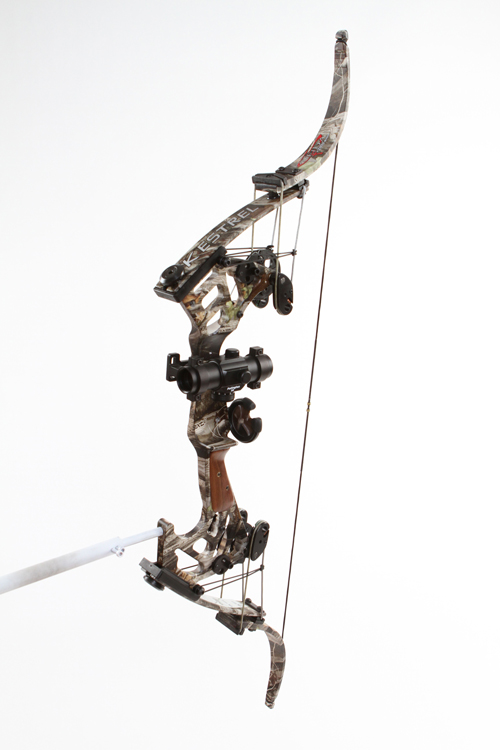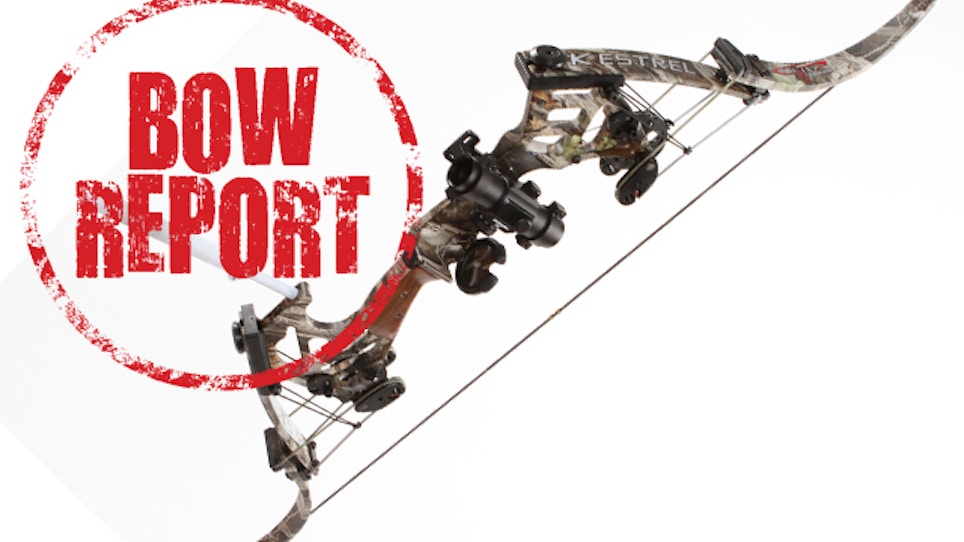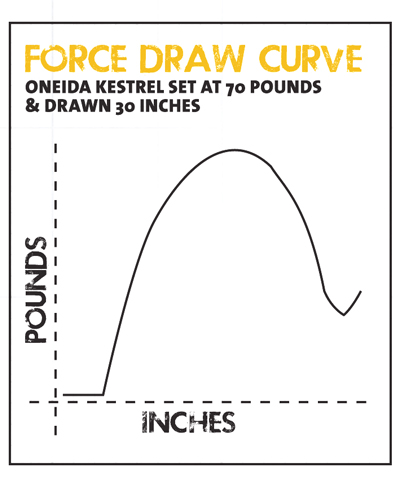A casual look at compound bow patents will reveal an amazing array of designs featuring multiple limbs, levers, wheels, pulleys, and cables in just about every imaginable configuration, mostly representing attempts to wring the maximum amount of efficiency out of the bow machine. Many have not gotten off the drawing board, and of those that have few designs have stood the test of time, apart from what has become the conventional configuration of risers attached to limbs with cams on axles at or near the ends of the limbs. The truly distinctive bows of C.P. Oneida Eagle (formerly the Oneida Bow Company) are an exception. Purchased in 2000 by one-time Oneida dealer Claude Pollington and moved to Michigan, the original Oneida Bow Company was founded in 1982 and from then until its purchase was located in upstate New York. It has had a dedicated following since its inception, and in more recent years has become increasingly popular for bowfishing.
On Oneida bows, the cams and idler wheels are affixed to the riser, with a timing cable running through the riser under the grip. Power cables are attached to power limbs, which are attached to outer limbs, or what Oneida calls outboard limbs. The string is unattached to cables or cams, but it loops around the limb tips in the manner of a recurve bow. There are some inherent advantages in this design. For one thing, the string is vertically centered, which avoids some problems associated with other configurations. Centershot truly is centershot on these bows, and nock travel tends to be level. There is no need for a cable guard to allow for fletching clearance, which avoids the torque that tends to be induced by cable guards. Finally, Oneida claims that the unique design of its bows makes them the smoothest-drawing compound bows in the world. (More about this later.)
 Draw weights for the Kestrel cover a 20-pound range; the buyer selects a bow that runs from 35 to 55 pounds, or one that covers the range from 50 to 70 pounds. Adjusting down 10 pounds from peak weight is a simple matter of turning the limb bolts as with any compound bow. Further adjustment requires loosening a timing screw on the cam. The timing screw can also be loosened to adjust tiller, should that be necessary. Regarding draw weight, each bow comes with a selection of modules for draw length and for 60, 75, or 80 percent letoff. A Positive Draw Control, consisting of a knurled nylon screw on the cam, can be adjusted to insure a firm back wall at full draw.
Draw weights for the Kestrel cover a 20-pound range; the buyer selects a bow that runs from 35 to 55 pounds, or one that covers the range from 50 to 70 pounds. Adjusting down 10 pounds from peak weight is a simple matter of turning the limb bolts as with any compound bow. Further adjustment requires loosening a timing screw on the cam. The timing screw can also be loosened to adjust tiller, should that be necessary. Regarding draw weight, each bow comes with a selection of modules for draw length and for 60, 75, or 80 percent letoff. A Positive Draw Control, consisting of a knurled nylon screw on the cam, can be adjusted to insure a firm back wall at full draw.
There is no denying that the design and overall appearance of Oneida bows are radically different from more conventional compound bows. Many shooters like it, some find it off-putting. It does look aggressive, and personally I find the short riser and the sharply curving outboard limbs a welcome change. On a less subjective note, fit and finish are excellent.
Shooting The Bow
Setting up the Kestrel is no different from setting up any other compound bow with one exception: Because there is no downward-moving cable on C. P. Oneida bows, most drop-away rests will not work with them. For that reason, instead of using the QAD Ultra-Rest that we normally use for testing, I used an Octane Hijack rest. Oneida bows’ strings are centered vertically, so I positioned the rest by eyeballing, aligning the arrow with the string. I then aligned the pin sights with the string and arrow when installing the sight, and it was remarkably close to dead-on, requiring only a few minor adjustments. Arrows came off the string like a dart, with no discernible porpoising or fish-tailing.
At 4.5 pounds the Kestrel can’t be described as light by current standards, but the grip is ergonomic and the bow is well-balanced, tending to tip back from the top at rest. Earlier I made reference to Oneida’s claims that its bows are the smoothest around. This is not hype. Having already used descriptors like “silky smooth” in describing some other bows, I’m at a loss for adjectives. It is possible there is a smoother-drawing compound bow somewhere, but I have not yet encountered it. Both the increase and the decrease from peak weight are even and gradual, with no sudden drop-offs, no humps or bumps, and no grabbiness from full draw. Don’t take my word for it; check out the draw force curve.
At the shot the bow pops forward slightly into the bow hand, but I was unable to detect any vibration whatsoever. Having said all that, this is not by current standards a quiet bow. It’s not a truly fast bow, either; C.P. Oneida has clearly opted for smooth-drawing, pleasant shooting qualities over speed. The outboard limbs swing back some distance at full draw, moving forward at the shot. This isn’t necessarily a problem. Many thousands of hunters—myself included—have taken no small number of game with Oneida bows. The movement of the limbs and possible interference with that movement is something to keep in mind, though, when shooting from a ground blind or a tree.
Oneida bows are very customizable in terms of draw weight, draw length, and letoff, and can be finely tuned. Partially as a result of that versatility, they allow for (or require, depending on your perspective) a little more tinkering than do more conventional compound bows. They are not bows that will appeal to every bowhunter, but in recent years have reclaimed a sizeable group of bowhunters who are passionate about their Oneida bows. Interestingly, they are especially popular among bowfishers, who tout them as ideal for snapshooting and like the smooth draw and high letoff, both qualities that are not common among bows that are good for snapshooting. Those same qualities will appeal to many bowhunters as well. And bowhunters for whom a soft, super-smooth draw is more important than speed will find that the Kestrel, as well as Oneida’s other offerings, are well worth a closer look.
ONEIDA KESTREL SPECS
Letoff:...................................... 65-80%
Brace Height:....................... 6 to 7 inches (varies with draw length and letoff)
Weight:.................................... 4.5 pounds
Axle-To-Axle Length:...... 42-43 inches
Speed:....................................... N/A
Draw lengths:....................... 24-30 inches, module-specific
Draw weights:...................... 35-55 pounds, 50-70 pounds
Options:.................................. Finishes: Next Gen G-1 or Flat Black.
Suggested Retail:.............. $1,395
OBJECTIVE TESTS (30 Inches Draw)
Peak Hold*:............................ 70 pounds
Weight, Full Draw*:.......... 14 pounds
Arrow Weight:..................... 385 grains.............. 500 grains
Arrow @70 Pounds*:....... 274 fps .................. 245 fps
Arrow @60 Pounds*:....... 252 fps................... 225 fps
K.E. @70 Pounds*:............ 64 ft. lbs................ 66.5 ft. lbs.
K.E. @60 Pounds*:............ 54.5 ft. lbs............. 56 ft. lbs.
Sound Level @60 Pounds:................................ 62.6 dBA.....60.7 dBA
*Rounded to nearest half-pound.







